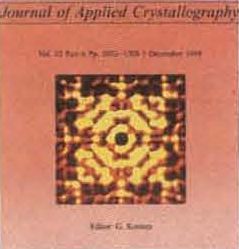


IUCr journals news
Imaging of the helical arrangement of cellulose fibrils in wood by microfocus X-ray diffraction

J. Appl. Cryst. 32 (1999), 1127-1133
![[Imaging]](https://www.iucr.org/__data/assets/image/0020/2990/7_4_2.gif)
X-ray diffraction patterns were recorded with a wavelength of 0.78 Å from cross-sections ~10 microns thick oriented perpendicular to the X-ray beam. The figure shows a two-dimensional array of 21 x 26 diffraction patterns recorded as the specimen was systematically stepped across the X-ray beam with a step size in each direction of 2 microns. The relative position of cell walls containing ordered cellulose fibrils gives rise to the well-defined X-ray fibre diffraction patterns illustrated in the figure. The dark regions in the matrix correspond to the region of intervening lumina. The two typical diffraction patterns displayed at higher magnification show a striking asymmetry which contrasts with the symmetry about the meridional axis typical of fibre diffraction patterns. This asymmetry was used to determine local fibril orientation and hence to trace the path of cellulose spirals through the specimen.
As the authors state, the technique is most interesting and powerful because it provides information about two length scales simultaneously, i.e., on the micrometric scale through the positional resolution of the scan of ~2 microns and on the nanometre scale through the diffraction patterns recorded at each point. The approach developed in these studies, and in particular the extensive mathematical description of the diffraction geometry for this type of sample, can be expected to have wide applications in the investigation of texture in industrial polymer materials and in the characterization of structural hierarchies in biological materials where the dimensions of ordered domains are comparable to the diameter of the X-ray beam.
Watson Fuller, Keele U., Staffordshire, UK

